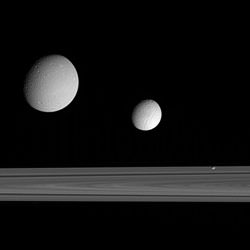
Dione, Tethys and Pandora. Image credit: NASA/JPL/SSI. Click to enlarge.
This excellent grouping of three moons –Dione, Tethys and Pandora– near the rings provides a sampling of the diversity of worlds that exists in Saturn’s realm.
A 330-kilometer-wide (205 mile) impact basin can be seen near the bottom right on Dione (at left). Ithaca Chasma and the region imaged during the Cassini spacecraft¿s Sept. 24, 2005, flyby can be seen on Tethys (middle). Little Pandora makes a good showing here as well, displaying a hint of surface detail.
Tethys is on the far side of the rings in this view; Dione and Pandora are much nearer to the Cassini spacecraft.
Dione is 1,126 kilometers (700 miles) across. Tethys is 1,071 kilometers (665 miles) across and Pandora is 84 kilometers (52 miles) across.
This image was taken in visible blue light with the Cassini spacecraft narrow-angle camera on Sept. 22, 2005, at a distance of approximately 1.2 million kilometers (800,000 miles) from Saturn. The image scale is about 5 kilometers (3 miles) per pixel on Dione and Pandora and 9 kilometers (6 miles) per pixel on Tethys.
The Cassini-Huygens mission is a cooperative project of NASA, the European Space Agency and the Italian Space Agency. The Jet Propulsion Laboratory, a division of the California Institute of Technology in Pasadena, manages the mission for NASA’s Science Mission Directorate, Washington, D.C. The Cassini orbiter and its two onboard cameras were designed, developed and assembled at JPL. The imaging operations center is based at the Space Science Institute in Boulder, Colo.
For more information about the Cassini-Huygens mission visit http://saturn.jpl.nasa.gov . The Cassini imaging team homepage is at http://ciclops.org .
Original Source: NASA/JPL/SSI News Release
